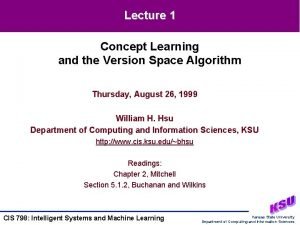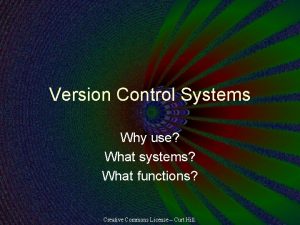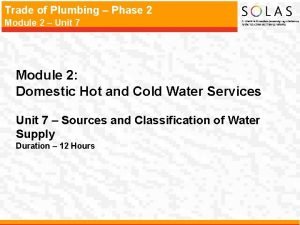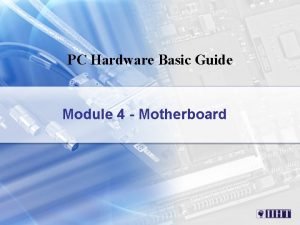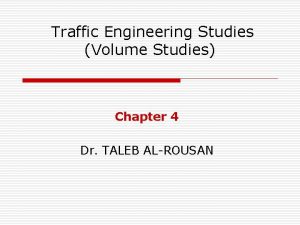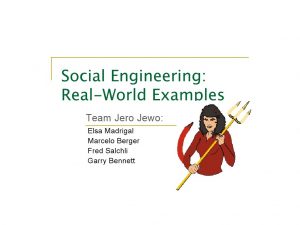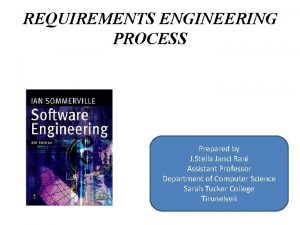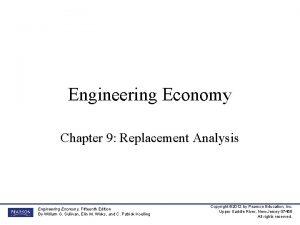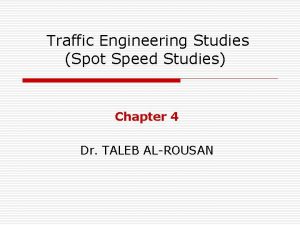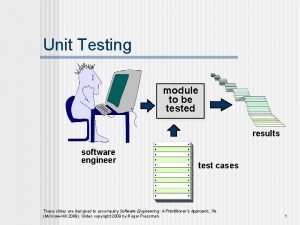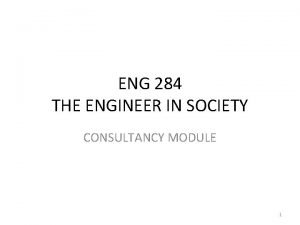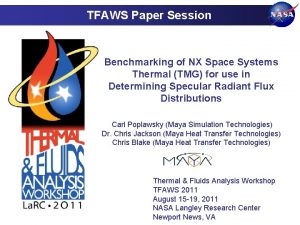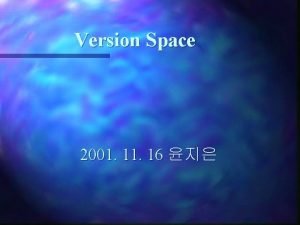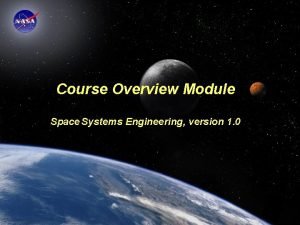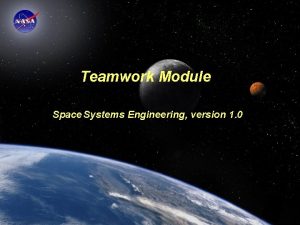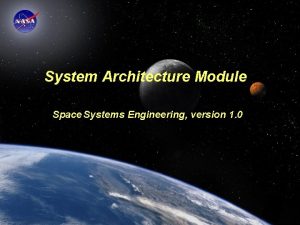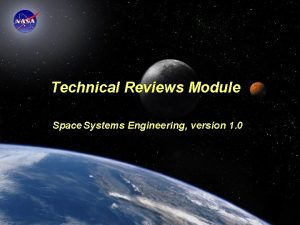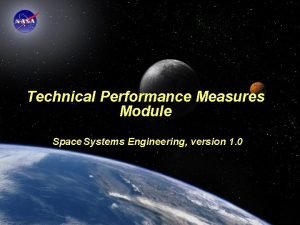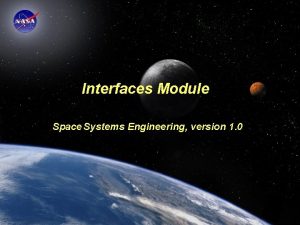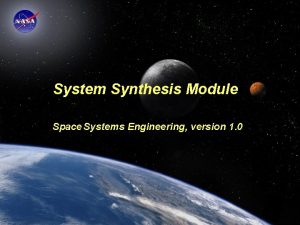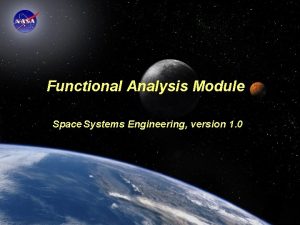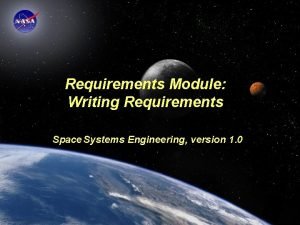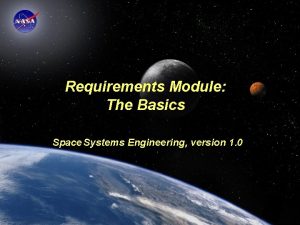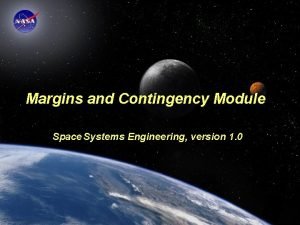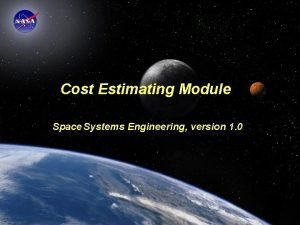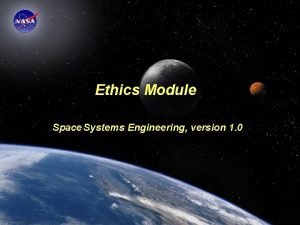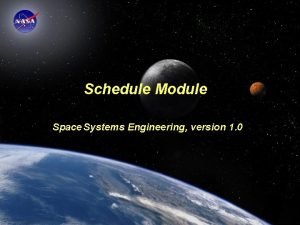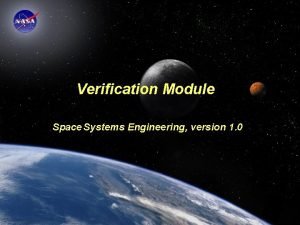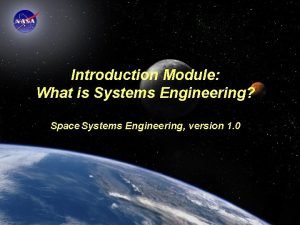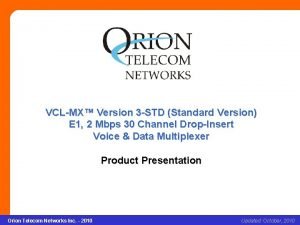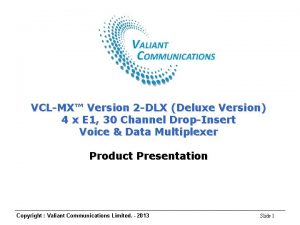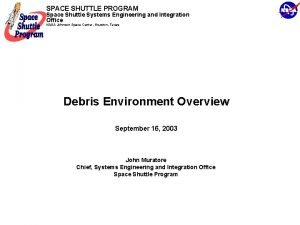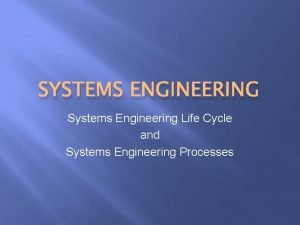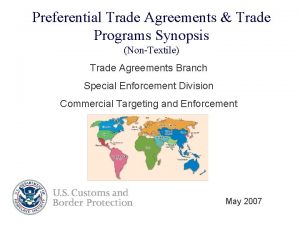Trade Studies Module Space Systems Engineering version 1

































- Slides: 33

Trade Studies Module Space Systems Engineering, version 1. 0 Space Systems Engineering: Trade Studies Module

Module Purpose: Trade Studies Describe the typical trade study process and show an example. Recognize that trade studies support decision making throughout the project lifecycle. Provide some trade study heuristics to improve the application and value of future trade studies. Describe and provide a trade tree - an option management graphic. Space Systems Engineering: Trade Studies Module 2

What is a Trade Study? A trade study (or trade-off study) is a formal tool that supports decision making. A trade study is an objective comparison with respect to performance, cost, schedule, risk, and all other reasonable criteria of all realistic alternative requirements; architectures; baselines; or design, verification, manufacturing, deployment, training, operations, support, or disposal approaches. A trade study documents the requirements, assumptions, criteria and priorities used for a decision. This is useful since new information frequently arises and decisions are reevaluated. Space Systems Engineering: Trade Studies Module 3

Trade Studies Support Decision Making Throughout the Development Lifecycle Trade studies support: • Requirements development - e. g. , to resolve conflicts; to resolve TBDs and TBRs • Functional allocations - e. g. , system architecture development • System synthesis - e. g. , assess the impact of alternative performance or resource allocations • Investigate alternate technologies for risk or cost reduction • Assess proposed design changes • Make/buy decisions (i. e. , build the part from a new design or buy from commercial, existing sources) Space Systems Engineering: Trade Studies Module 4

The Trade Study Process (1/2) 1. Define the objectives of the trade study 2. Review inputs, including the constraints and assumptions 3. Choose the evaluation criteria and their relative importance (these can be qualitative) 4. Identify and select the alternatives 5. Assess the performance of each option for each criteria 6. Compare the results and choose an option 7. Document the trade study process and its results Space Systems Engineering: Trade Studies Module 5

The Trade Study Process (2/2) Space Systems Engineering: Trade Studies Module 6

Evaluation Criteria — Measures (1/2) Trade studies depend upon having criteria for making decisions based on measures of effectiveness (voice of the customer) and measures of performance (voice of the engineer). Measure of Effectiveness (MOE) - A measure of how well mission objectives are achieved. MOEs are implementation independent - they assess ‘how well’ not ‘how’. Example measures of effectiveness include • • • Life cycle cost Schedule, e. g. , development time, mission duration Technology readiness level (maturity of concept/hardware) Crew capacity Payload Mass Space Systems Engineering: Trade Studies Module 7

Evaluation Criteria — Measures (2/2) Measure of Performance (MOP) - A quantitative measure that, when met by the design solution, will help ensure that an MOE for a product or system will be satisfied. There are generally two or more measures of performance for each MOE. Example measures of performance • • • Mass Power consumption Specific impulse Consumables required Propellant type Both MOEs and MOPs are system figures of merit; an MOE refers to the effectiveness of a solution and an MOP is a measure of a particular design. Space Systems Engineering: Trade Studies Module 8

Trade Study Heuristics 1. Rules of Thumb: ü Manage the number of options under consideration ü Revisit the original problem statement ü If a baseline solution is established, use it as a ‘yardstick’ to measure the alternatives. 2. Decisions are frequently made with imperfect information. 1. Do not get stuck in ‘analysis paralysis’. 2. Decide how deep the analysis must go. {Deep enough to make a decision with confidence, but no deeper. } 3. Does the decision feel right? If not, why? 4. Conduct further what-if scenarios by changing assumptions. 5. Reject alternatives that do not meet an essential requirement. 6. Ignore evaluation criteria that do not discriminate between alternatives. 7. Trades are usually subjective; numeric results usually give a false sense of accuracy. 8. If an apparent preferred option is not decisively superior, further analysis is warranted. Space Systems Engineering: Trade Studies Module 9

Example Decision Matrix Trade Study Preferred Solution Space Systems Engineering: Trade Studies Module 10

Example Qualitative Decision Matrix For a Lunar Thermal Control Trade Study Characteristics Single Phase Fluid Two Phase Fluid Heat Pipe Safety: (3) Operating Pressure Low High Low-Medium Safety: Toxicity Fluid Dependent Safety: Flammability Fluid Dependent Reliability (1) High Fair Performance: (2) Pumping Cost Low High Fair Complexity: (4) Controls Simple Nominal Complexity: (5) Simple Manufacturing Difficulty Space Systems Engineering: Trade Studies Module Nominal Complex 11

Do A Reality Check On The Tentative Selection Key questions to ask: Have the requirements and constraints truly been met? Is the tentative selection heavily dependent on a particular set of input values and assumptions, or does it hold up under a range of reasonable input values (i. e. , is it ‘robust’)? Are there sufficient data to back up the tentative selection? Are the measurement methods sufficiently discriminating to be sure that the tentative selection is really better than the alternatives? • If close results, is further analysis warranted? Have the subjective aspects of the problem been fully addressed? Test the decision robustness. • Is the tentative selection very sensitive to an estimated performance or constraint? If so, explore the full reasonable range of each performance variable to understand the domain where your tentative selection is appropriate. Space Systems Engineering: Trade Studies Module 12

Trade Trees A trade tree is a graphical method of capturing alternatives with multiple variables. Each layer of the tree represents some aspect of the system that will be treated in a trade study to determine the best alternative. Some alternatives can be eliminated (or ‘pruned’) a priori because of technical feasibility, launch vehicle constraints, cost, risk or some other disqualifying factor. The total number of alternatives is given by the number of end points of the tree. Even with just a few layers, the number of alternatives can increase quickly, so manage their numbers. Space Systems Engineering: Trade Studies Module 13

Top-level Trade Tree-Example for Mars Œ 1988 “Mars Expedition” 1989 “Mars Evolution” 1990 “ 90 -Day Study” 1991 “Synthesis Group” 1995 “DRM 1” 1997 “DRM 3” 1998 “DRM 4” 1999 “Dual Landers” 1989 Zubrin, et. al* 1994 -99 Borowski, et. al 2000 SERT (SSP) 2002 NEP Art. Gravity 2001 DPT/NEXT M 1 2005 MSFC MEPT M 2 2005 MSFC NTP MSA Decision Package 1 Long vs Short Conjunction Class Long Surface Stay Opposition Class Short Surface Stay NTR Electric Chemical 13 14 15 16 17 18 19 20 21 22 23 24 25 26 27 ” “ • ‘ ’ M 1 • M 2 M 1 Space Systems Engineering: Trade Studies Module No ISRU NTR Electric Chemical 10 11 12 ISRU NTR Electric Chemical 7 8 9 ISRU Propulsive NTR Electric Chemical 4 5 6 ISRU Aerocapture NTR Electric Chemical 3 1 2 ISRU Propulsive NTR Electric Chemical ISRU NTR Electric Chemical No ISRU Aerocapture NTR Electric Chemical No ISRU Propulsive NTR Electric Chemical No ISRU Aerocapture All-up NTR Electric Chemical Propulsive Pre-Deploy No ISRU (no hybrids in Phase 1) All-up NTR Electric Chemical Aerocapture Special Case 1 -year Round-trip ƒ Pre-Deploy Mars Ascent Mars Capture Propellant Method Interplanetary Propulsion Human Exploration Of Mars NTR Electric Chemical Cargo Deployment Mission Type Ž ‘ ’ “ ” • ‚ 28 29 30 31 32 33 34 35 36 37 38 39 40 41 42 43 44 45 46 47 48 No ISRU M 2 Ž‚ M 2 ISRU No ISRU Œ M 2 NTR- Nuclear Thermal Rocket Electric= Solar or Nuclear Electric Propulsion 14

Earth-Moon Transit Trade Tree High Priority Medium Priority Low Priority 2, 3 1, 4&C 4, 5 -8, 12 9, 13 7, 8 11 1, 3 -6, 10, 12 H = Human Mission Segment 2, 11 C = Cargo Mission Segment 10 9, 13 C 1 -3, 5 -13 H C Orbital Operations & Earth-Moon Transit; Propulsion Options All Chemical 1 -4, 7 -13 L Chemical + Electric 5 NTR 6 Other Hybrid Options Space Systems Engineering: Trade Studies Module K Lunar Descent/Ascent Lander Options Integrated Crew Transit/Lander Function Earth EDL Orbit Capture Options M 13 Modular Elements 1 -12 Earth Entry Vehicle L/D Options Aerocapture 7 Propulsive Capture 8 N/A Low L/D N 1 -11, 13 Medium L/D 12 High L/D N/A 1 -6, 9 -13 15

Example: Earth-Moon Transit Trade Option Analyses Key measure of performance: mass Space Systems Engineering: Trade Studies Module 16

Further Considerations for Trade Studies and Class Discussion Based on Observations from The University of Texas at Austin Senior Mission Design Class, 2007 (Department of Aerospace Engineering) Space Systems Engineering: Trade Studies Module

Trade Study Considerations (1/4) Assumptions Trade studies are based on assumptions the team makes. Examples of driving assumptions: • Crew size assumption drives the amount of consumables and the viability of an open ECLSS versus partially closed ECLSS. • Mission duration assumption drives the amount of power required which in turn drives the choice of power subsystem. • Landing location on the moon drives delta-v requirements which in turn drives best orbit selection and propulsion subsystem. Changing assumptions within the trade study allows the team to perform a ‘what-if’ analysis. • Allows the team to understand the integrity of the design alternative selected • Shows the importance of that assumption Space Systems Engineering: Trade Studies Module 18

Trade Study Considerations (2/4) Mission environment The trade space for subsystem alternatives is often defined by the space environment for the mission. • Why use RTGs when the mission is at 1 AU or on the Moon. When do we use RTGs? For deep space missions where solar intensity is less. • Types of thermal control - need to consider the operating temperature extremes • Types of rendezvous and ‘landing’ with a NEO - need to understand the orbit, spin and known composition of asteroid • Sometimes the worst of the space environment, such as a solar particle event (SPE) for radiation, can be avoided by operational solutions rather than design solutions, i. e. , perform the mission during the minimum of the solar cycle or using early warning sentinel satellites. • Lunar missions - is your system operating at one particular location or region (like Apollo at equatorial latitudes), or at global sites depending on the particular mission? Space Systems Engineering: Trade Studies Module 19

Trade Study Considerations (3/4) Importance of information for each alternative Trade study analysis should use information that is relevant. Extraneous information can distract the decision maker. ‘Materials’ example: • Do material characteristics such as tensile strength and Poisson’s ratio really matter in the selection process. • In considering so many material alternatives, was heritage considered as a design factor, i. e, has this material flown on previous space missions? • If not, what is the cost to your project for bringing that technology up to flight-ready status? • Did you violate one of your original mission scope assumptions of using current state-of-the-art technology? • In considering material alternatives, were other correlated factors included which would shorten the trade space to begin with, such as material’s impact on radiation protection; use for a pressure vessel vs. landing struts. Space Systems Engineering: Trade Studies Module 20

Trade Study Considerations (4/4) Trade study vs. spacecraft design Is a trade study really necessary? • Cargo capsule example: • Structural design of capsule is not a trade. Evaluation criteria are the design characteristics; heritage is reference information for actual design work. • Seismic vehicle example: • Two existing concepts versus determining which characteristics are most valuable for your team design to include • Mars habitat example: • What are the communications requirements for the mission (voice, video, etc) => amount of bandwidth to specify for comm subsystem. What makes for a successful mission? Answer defines which trades are of most importance & might drive additional trades. • Maximum surface exploration time => robust power and ECLSS • Precise NEO orbit tracking for X years => tracking method • 1 -week cargo delivery => launch vehicle availability and mission plan Space Systems Engineering: Trade Studies Module 21

Module Summary: Trade Studies Trade studies are common decision-support tools that are used throughout the project lifecycle to capture and help assess alternatives. The steps in the trade study process are: 1. 2. 3. 4. 5. 6. 7. Define the objectives of the trade study Review inputs, including the constraints and assumptions Choose the evaluation criteria and their relative importance Identify and select the alternatives Assess the performance of each option for each criteria Compare the results and choose an option Document the trade study process and its results Trade trees are graphical tools that help manage multivariable options. Space Systems Engineering: Trade Studies Module 22

Back-up Slides for Trade Studies Module Space Systems Engineering: Trade Studies Module

Trade Studies The systems engineering method relies on making design decisions by the use of trade studies. Trade studies are necessary when the system is complex and there is more than one design approach. Trade studies involve the comparison of alternatives • Good to explore a number of different alternatives • Alternatives should be compared at the same level of detail • Key is for characteristics to be evaluated relative to one another Trade study approaches: • Comparing advantages and disadvantages of several alternatives; can be qualitative. • Using a formal ranking system based on multiple criteria and a weighting system; quantitative approach. Space Systems Engineering: Trade Studies Module 24

Example Trade Study Outline Purpose of Study • Resolve an Issue • Perform Decision Analysis • Perform Analysis of Alternatives (Comparative analysis) Scope of Study • State level of detail of study • State Assumptions • Identify Influencing requirements & constraints Trade Study Description • Describe Trade Studies To Be Performed • The Studies Planned To Make Tradeoffs Among Concepts, User Requirements, System Architectures, Design, Program Schedule, Functional, Performance Requirements, And Lifecycle Costs • Describe Trade Methodology To Be Selected • Describe Technical Objectives • Identify Requirements And Constraints • Summarize Level of Detail of Analysis Analytical Approach • Identify Candidate solutions to be studied/compared • Measure performance o Develop models and measurements of merit o Develop values for viable candidates • Selection Criteria -- risk, performance, and cost are usually at lease three of the factors • Scoring o Measures of results to be compared to criteria • Weighted reflecting their relative importance in the selection process • Sensitivity Analysis Trades Results • Select User/Operational Concept • Select System Architecture • Derive Requirements o Performing trade studies to determine alternative functional approaches to meet requirements o Alternate Functional Views o Requirements Allocations • Derive Technical/Design Solutions • Cost Analysis Results • Risk Analysis Results Space Systems Engineering: Trade Studies Module • Understand Trade Space 25

Decisions to Make Before Beginning a Trade Study Has success been defined? Which trades need to be done and at what phase of the project? For each trade what criteria will be used and what are their relative weights? How deep will the analysis go? • Deep enough to make a decision with confidence, but no deeper. Criteria for doing a trade study? • The easiest trade study to do is the one that does not have to be done. • Do not do a trade study just because you can. Space Systems Engineering: Trade Studies Module 26

Trade Study Process Define Evaluation Criteria/ Weighting factors Study Inputs: § Constraints § Ops Concept § Existing requirements § Assumptions § Relevant plans & documents Determine Scope of the Trade Study Generate Viable Alternative Solutions Space Systems Engineering: Trade Studies Module Evaluate Alternatives Against Criteria Create Trade Tree Perform Sensitivity Analyses TRADE STUDY RESULTS § Data - graphical § Recommended approach § Benefits § Resulting risk posture § Summary of results § Summary of approach 27

Focused Trade Study Phase I Analysis Mass Estimation Benchmark “Pseudo-Apollo” Baseline Reference Mission Requirements Design Environments Subsystem Technologies Architectural Variations Parametric Variations • • 2 -launch solution • Alternate propellants. 3 -launch solution 25 mt launch constraint • Alternate power sources. • Variation in return payload Initial CEV/lander mating in LEO • Variation of delivered payload to the lunar surface • Single pass aerocapture, deorbit phasing, and capability of landing • All versus partial crew to the lunar surface • Reduce crew size to 2 • Increase crew size to 6 • Change in time between launches (7 to 30 days) • Reduce lunar surface stay time to 3 days • Increase lunar surface stay time to 14 days • Effects of elimination of CEV contingency EVA requirement • Mass effect of supplemental radiation shielding Architectural Variation • Lunar Orbit Rendezvous of CEV/lander Space Systems Engineering: Trade Studies Module 28

Focused Trade Study Results Mission Design Reference Operations Concept MOON ht Low Lunar Orbit Expended ig L 1 (~322, 000 km) ig 8 0 0 ht 4 weeks 3 Ti -Da m y e Fl ig ht 4 Ti -Da m y e Fl 5 Ti -Da m y e Fl 9 0 0 Kick Stage Expended 8 0 0 9 0 10 0 00 11 00 120 0 13 00 Earth Departure Stage Expended Service Module Expended LEO 407 km Water Landing Initial Mass in LEO Continue CEV Missions Reused? EARTH Key Figures of Merit Safety Effectiveness • • • # of Critical Events Mission Complexity Abort Options Crew Time Technology Risk Probability of launch success • Etc. Space Systems Engineering: Trade Studies Module Total Mass Dry Mass Surface Time Etc. Extensibility • • Long-Stays Mars Other destinations Etc. 29

Affordability Trades Space Systems Engineering: Trade Studies Module 30

Broad Trade Study Overview Multi-center team assessed potential mission concept trade options around two broad Lunar Mission Scenarios • LMS-1 - global access, 7 -day surface stays • LMS-2 - south pole access, 30 -90 day surface stays Screening of breakthrough technologies conducted for applicability to Spirals 1 and 2 Trade tree defined for each LMS served as the basis for trade option identification Initial down-selection of major trade tree branches was performed to: • Establish data/rationale for potentially infeasible mission concepts • Provide focus on trade options to be analyzed in more detail Analysis of numerous trades and options conducted LMS Trade Tree Definition Trade Option Analyses • LMS-1: 10 trade options + alternatives • LMS-2: 13 trade options + alternatives Space Systems Engineering: Trade Studies Module Sensitivity Analyses 31

Example: Trade Option Analyses Space Systems Engineering: Trade Studies Module 32

ECLSS Design Options for a Lunar Rover Design Factor Option 1 Option 2 Option 3 Recovery Open Partially Closed Totally Closed Consumables Non-regenerate Base regenerate Vehicle regenerate O 2 Carry all Carry part; recover part from CO 2 & H 2 O CO 2 Absorb, dump Absorb, carry back to base Regenerate in vehicle H 2 O Absorb, dump Condense and carry back or sublimate Electrolysis in vehicle Cooling Sublimator Radiator Losses O 2 & H 2 O Only lose water Nothing for cooling by sublimator; O 2 is recovered at base Space Systems Engineering: Trade Studies Module 33
 Dicapine
Dicapine Engineering elegant systems: theory of systems engineering
Engineering elegant systems: theory of systems engineering Hypothesis space in machine learning
Hypothesis space in machine learning Version control systems industry
Version control systems industry Paradigm shift from women studies to gender studies
Paradigm shift from women studies to gender studies Trade diversion and trade creation
Trade diversion and trade creation Umich
Umich Trade diversion and trade creation
Trade diversion and trade creation The trade in the trade-to-gdp ratio
The trade in the trade-to-gdp ratio Fair trade not free trade
Fair trade not free trade Trade diversion and trade creation
Trade diversion and trade creation Tramp shipping and liner shipping
Tramp shipping and liner shipping Triangular slave trade
Triangular slave trade Phase 2 plumbing
Phase 2 plumbing C device module module 1
C device module module 1 Module 4 topic 2 components of the space management system
Module 4 topic 2 components of the space management system Andy fisher mun
Andy fisher mun Parking studies in traffic engineering
Parking studies in traffic engineering Monthly expansion factor formula
Monthly expansion factor formula Social engineering case studies
Social engineering case studies Feasibility studies for requirements engineering process
Feasibility studies for requirements engineering process Replacement studies engineering economics
Replacement studies engineering economics Spot speed studies
Spot speed studies Module testing in software engineering
Module testing in software engineering Module engineering consultant
Module engineering consultant Module 10 topic 3 drivers ed
Module 10 topic 3 drivers ed Module 4 operating systems and file management
Module 4 operating systems and file management Module 10 the nervous and endocrine systems
Module 10 the nervous and endocrine systems Cartesian space trajectory planning
Cartesian space trajectory planning Space junk the space age began
Space junk the space age began Camera space to world space
Camera space to world space Cartesian space vs joint space
Cartesian space vs joint space World space to screen space
World space to screen space Nx space systems thermal
Nx space systems thermal


